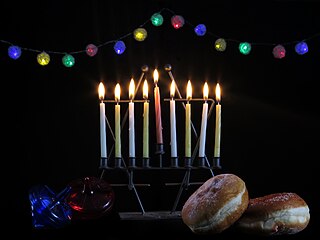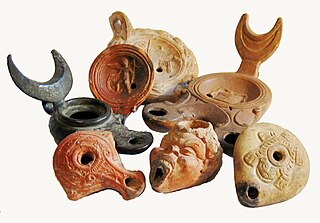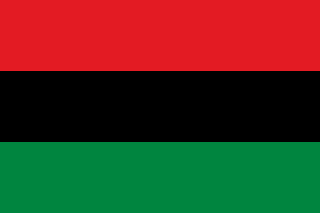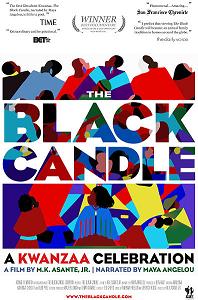This article needs additional citations for verification .(January 2021) |

The kinara is a seven-branched candleholder used in Kwanzaa celebrations in the United States.
This article needs additional citations for verification .(January 2021) |

The kinara is a seven-branched candleholder used in Kwanzaa celebrations in the United States.
Shortly before the first celebration in 1966, Maulana Karenga searched for a candle holder with seven holes in which he and the other US Organization members could use to celebrate the first Kwanzaa. However, absent the presence of a handcrafted kinara, two holders were broken from a Hanukkah menorah which was then used to hold the seven candles. The following year, US Organization member Buddy Rose-Aminifu crafted the first kinara. Early photographs of the first kinara show that it was of rudimentary design, being a wooden log with holes drilled into it to support the candles. [1] [2]
During the week-long celebration of Kwanzaa, seven candles are placed in the kinara—three red on the left, three green on the right, and a single black candle in the center. The word kinara is a Swahili word that means candle holder.
The seven candles represent the Seven Principles (or Nguzo Saba) of Kwanzaa. Red, green, and black are the symbolic colors of the holiday.
During the week of Kwanzaa, a new candle is lit on the kinara each day. The center black candle is lit first, and the lighting then proceeds from left to right, the new candle being lit corresponding to the principle of that day. In this way, each day of Kwanzaa is dedicated to the contemplation of one of the Seven Principles. The first known use of the word "Kinara" is dated 1975. [3]
Each of the candles also has a meaning. The black one symbolizes the African people, the red their struggle, and the green the future and hope that comes from their struggle.

Hanukkah is a Jewish festival commemorating the recovery of Jerusalem and subsequent rededication of the Second Temple at the beginning of the Maccabean Revolt against the Seleucid Empire in the 2nd century BCE.

Kwanzaa is an annual celebration of African-American culture from December 26 to January 1, culminating in a communal feast called Karamu, usually on the sixth day. It was created by activist Maulana Karenga, based on African harvest festival traditions from various parts of West and Southeast Africa. Kwanzaa was first celebrated in 1966. Estimates of how many Americans celebrate Kwanzaa have varied in recent years, from as few as a half a million to as many as 12 million.

The menorah is a seven-branched candelabrum that is described in the Hebrew Bible and in later ancient sources as having been used in the Tabernacle and in the Temple in Jerusalem. Into prehistory, its iconography can be traced to representations of the sacred tree. Since ancient times, it has served as a symbol representing the Jewish people and Judaism in both the Land of Israel and the Diaspora. It eventually became the State of Israel's official emblem after its founding in 1948.

An oil lamp is a lamp used to produce light continuously for a period of time using an oil-based fuel source. The use of oil lamps began thousands of years ago and continues to this day, although their use is less common in modern times. They work in the same way as a candle but with fuel that is liquid at room temperature, so that a container for the oil is required. A textile wick drops down into the oil, and is lit at the end, burning the oil as it is drawn up the wick.

A wreath is an assortment of flowers, leaves, fruits, twigs, or various materials that is constructed to form a ring shape.

The Pan-African flag is a tri-color flag consisting of three equal horizontal bands of red, black, and green. The Universal Negro Improvement Association and African Communities League (UNIA-ACL) formally adopted it on August 13, 1920, in Article 39 of the Declaration of the Rights of the Negro Peoples of the World, during its month-long convention at Madison Square Garden in New York City. Variations of the flag can and have been used in various countries and territories in the Americas to represent Garveyist ideologies.

The Advent wreath, or Advent crown, is a Christian tradition that symbolizes the passage of the four weeks of Advent in the liturgical calendar of the Western church. It is traditionally a Lutheran practice, although it has spread to many other Christian denominations.

Maulana Ndabezitha Karenga, previously known as Ron Karenga, is an American activist, author and professor of Africana studies, best known as the creator of the pan-African and African-American holiday of Kwanzaa.

A Hanukkah menorah, or hanukkiah, is a nine-branched candelabrum lit during the eight-day Jewish holiday of Hanukkah. Eight of the nine branches hold lights that symbolize the eight nights of the holiday; on each night, one more light is lit than the previous night, until on the final night all eight branches are ignited. The ninth branch holds a candle, called the shamash, which is used to light the other eight.
US Organization, or Organization Us, is a Black nationalist group in the United States founded in 1965. It was established as a community organization by Hakim Jamal together with Maulana Karenga. It was a rival to the Black Panther Party in California. One of the early slogans was, "Anywhere we are US is." "US" referred to "[us] black people" in opposition to their perceived oppressors ("them").

The ceremonial use of lights occurs in liturgies of various Christian Churches, as well as in Jewish, Zoroastrian, and Hindu rites and customs.
Holiday stamps are a type of postage stamp issued to commemorate a particular religious festival or holiday.
Umoja, the Swahili word for "unity", may refer to:

The Christmas season or the festive season is an annual period recognized in many Western and other countries that is generally considered to run from late November to early January. It is defined as incorporating at least Christmas Day, New Year's Day, and sometimes various other holidays and festivals. It also is associated with a period of shopping which comprises a peak season for the retail sector and a period of sales at the end of the season. Christmas window displays and Christmas tree lighting ceremonies when trees decorated with ornaments and light bulbs are illuminated are traditions in many areas.
A Hanukkah stamp is a holiday stamp issued to commemorate Hanukkah. Since 1996, several Hanukkah-themed postage stamps have been issued, often jointly.

The Black Candle is a documentary film about Kwanzaa directed by M. K. Asante and narrated by Maya Angelou. The film premiered on cable television on Starz on November, 2012.

A public menorah is a large menorah displayed publicly during the Jewish holiday of Hanukkah. It is done to celebrate the holiday and publicize the miracle of Hanukkah, and is typically accompanied by a public event during one of the nights of Hanukkah attended by invited dignitaries who are honored with lighting the menorah.

The White House Hanukkah Party is an annual reception held at the White House and hosted by the U.S. President and First Lady to recognize and celebrate the Jewish festival of Hanukkah. The tradition was established in 2001, during the administration of George W. Bush. The guest list includes hundreds of American Jewish politicians, organization heads, and school and yeshiva deans.

Miracle of the cruse of oil, or the Miracle of Hanukkah, is an Aggadah depicted in the Babylonian Talmud as one of the reasons for Hanukkah. In the story, the miracle occurred after the liberation of the Temple in Jerusalem during the Maccabean Revolt, and it describes the finding of a jug of pure oil that was to be enough to light the lamp for one day, but that lasted for eight days.
Rosh Chodesh L'Banot, also known as Chag HaBanot, and in Arabic as Eid al-Banat, is a holiday celebrated by some Jewish communities in the Middle East on Rosh Chodesh of the Jewish month of Tevet, during the Jewish holiday of Chanukah. The Jewish community where the holiday was most preserved is in Tunisia. But there is also evidence that it was also celebrated in Jewish communities in Libya, Algeria, Kushta, Istanbul, Morocco and Thessaloniki.